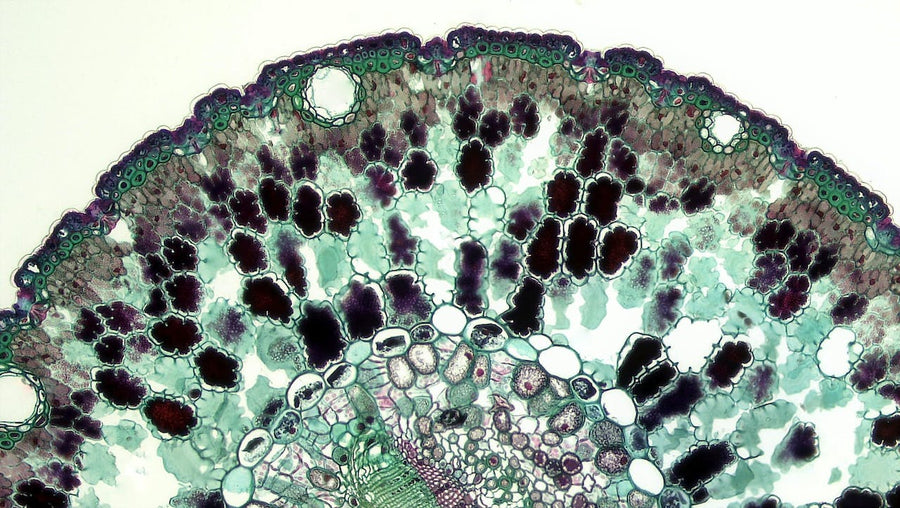What Are Follicles in IVF & Why Are They Important?

By OBGYN Dr. Kenosha Gleaton
Understanding Follicles in the Context of IVF
Follicles are an important part of the female reproductive system. Not only do follicles house eggs that are required for conception, but measuring follicle growth is a key part of IVF. Let’s break down what follicles are and how they relate to fertility treatments.
What Is a Follicle?
Ovarian follicles are fluid-filled sacs found in the ovaries. [1-2] The follicles contain immature and developing eggs. When we reference ovulation or the release of an egg, we’re talking about a mature egg rupturing and breaking free from an ovarian follicle. Follicles also secrete hormones that have a large influence on the stages of the menstrual cycle. [1-2]
The Role of Follicles in Fertility and IVF
The three key steps needed to conceive are the presence of a healthy egg, healthy sperm, and a path for the two to meet. Healthy eggs come from ovarian follicles, and each follicle has the potential to release an egg for fertilization about once a month. [1-2]
Ovarian follicles also play an important role in assisted reproductive technology (ART) such as in vitro fertilization (IVF). IVF is a fertility treatment that involves retrieving eggs from the ovaries, fertilizing the egg with sperm outside of the body, and then transferring the fertilized egg back into the uterus for implantation. [3] In IVF, the ovaries are stimulated with hormones to encourage follicle growth. Healthcare providers will monitor the process of the follicles, including the size of the follicles and how many have grown. When the time is right, a trigger shot (injection of hCG) will be given. [3] This prompts the follicles to release the mature eggs, which will then be collected during an egg retrieval procedure. [3]
The short version: follicles house eggs, which are a key part of the conception process.
The Journey of a Follicle During IVF
Follicles will enter a few different stages during your TTC journey. Let’s take a closer look at the journey of a follicle during IVF.
From Primordial to Mature Follicles
Folliculogenesis (the process of an ovarian follicle growing and developing) can be a long process, taking about one year for a follicle to grow from its first stage- primordial follicle- to a mature stage. [1-2] People assigned female at birth are born with one to two million primordial follicles and have approximately 450,000 primordial follicles by the time they reach puberty. [1-2] Primordial follicles transition into primary follicles, which then transition into secondary follicles, eventually becoming preantral follicles and finally, an antral (mature) follicle. [2] This growth and development of the follicle occurs as a result of egg growth, cell division, and hormones. Antral follicles are the final stage of maturation that occurs before ovulation. [1-2]
This maturation process happens in many people without the help of any drugs or hormones and will almost always result in just one egg being released. [1-2] However, in IVF, patients will receive injections of follicle-stimulating hormone (FSH), luteinizing hormone (LH), or both, to facilitate the growth of multiple follicles. [3] This is commonly known as ovarian stimulation.
- 1: Primordial to primary stage
- 2: Secondary to early antral stage
- 3: Late antral to preovulatory stage
- 4: Ovulation
- 5: Corpus luteum, a normal cyst that forms on the ovary after an egg is released
Monitoring Follicle Development in IVF
The use of ultrasounds and blood tests gives healthcare providers a way to closely monitor follicle development when undergoing IVF. [3] While hormone injections are being given, the provider will track developing follicles to ensure enough follicles are growing to have a successful egg retrieval process. Blood tests can also give providers an idea of how someone is responding to the ovarian stimulation medications. [3] Once the provider confirms that enough follicles have developed, the trigger shot that induces ovulation will be given about 34 to 36 hours before the egg retrieval procedure. [3] Learn how to support ovarian health with supplements like Inositol and women's prenatal vitamins, or shop the ovulation test kit >>
How Many Follicles Are Normal for IVF?
There is no perfect number when counting follicles for IVF, but generally speaking, providers tend to agree that anywhere between 15 and 30 antral follicles indicate a good likelihood of success. [4]
Factors Influencing Follicle Count and Quality
There are many factors that can influence follicle count and quality, including social, environmental, and biological factors. [5] Age is one of the most commonly reported factors for low follicle count or quality. Exact age may vary, but researchers have noted that declines tend to occur more rapidly in people assigned female at birth after age 35-37.5. [6-7] Other factors include a history of smoking, alcohol use, exposure to toxins, underlying conditions, hormone balance, and more. [1-2,5] People can also respond to ovarian stimulation medicines differently. Some may require higher doses or another round of stimulation to see adequate growth, while others may see too many follicles developing, raising their risk of ovarian hyperstimulation syndrome (OHSS). [3]
The IVF Trigger Shot and Follicle Growth
One key part of the IVF journey is what many people call the trigger shot. The trigger shot is an injection of the hormone hCG, and it is necessary for the maturation of eggs before egg retrieval. [3-4] HCG helps the eggs complete meiosis, a type of cell division that reduces the number of chromosomes in the eggs. [8]
Do Follicles Still Grow After Trigger Shot?
Yes, follicles can still grow after a trigger shot is given. Most providers will be looking for only 2-3 mature follicles, with several others measuring close behind. [9] This is because the small to medium-sized follicles often continue to grow and mature on the day of the hCG injection and the day of egg retrieval. [9]
Timing and Impact of the IVF Trigger Shot
The trigger shot can be administered by yourself or a loved one. Providers will give more detailed instructions, but the trigger shot is typically timed 34-36 hours before the egg retrieval procedure is scheduled to occur. [3] This final injection is what prompts the mature oocytes (eggs) to rupture from the mature follicles. Read an overview of preparing for IVF or learn about the IVF funnel.
Maximizing Your IVF Success with Natalist
IVF, IUI, and other fertility treatments can come with a rollercoaster of emotions. In many ways, it can feel as though your fertility is out of your control. Natalist was founded by doctors and moms who have been in your shoes, and understand the many ups and downs of the TTC journey. Natalist supplements, tests, books, and other products were formulated with the patient experience in mind. Keep reading about fertility treatments on the Natalist blog, or browse TTC products like early pregnancy test strips.
References:
- Williams CJ, Erickson GF. Morphology and Physiology of the Ovary. [Updated 2012 Jan 30]. In: Feingold KR, Anawalt B, Blackman MR, et al., editors. Endotext [Internet]. South Dartmouth (MA): MDText.com, Inc.; 2000-. Available from: https://www.ncbi.nlm.nih.gov/books/NBK278951/
- Cox E, Takov V. Embryology, Ovarian Follicle Development. [Updated 2023 Aug 14]. In: StatPearls [Internet]. Treasure Island (FL): StatPearls Publishing; 2023 Jan-. Available from: https://www.ncbi.nlm.nih.gov/books/NBK532300/
- In vitro fertilization (IVF). Mayo Clinic. September 2023. https://www.mayoclinic.org/tests-procedures/in-vitro-fertilization/about/pac-20384716
- IVF Follicles: How Many Do You Need for Success? Southern California Reproductive Center. November 2017. https://blog.scrcivf.com/ivf-follicles-how-many-follicles-do-you-need-for-success
- Zhu, Q., Li, Y., Ma, J. et al. Potential factors result in diminished ovarian reserve: a comprehensive review. J Ovarian Res 16, 208 (2023). https://doi.org/10.1186/s13048-023-01296-x
- Bozdag G, Calis P, Zengin D, Tanacan A, Karahan S. Age related normogram for antral follicle count in general population and comparison with previous studies. Eur J Obstet Gynecol Reprod Biol. 2016;206:120-124. doi:10.1016/j.ejogrb.2016.09.013
- Rosen MP, Sternfeld B, Schuh-Huerta SM, Reijo Pera RA, McCulloch CE, Cedars MI. Antral follicle count: absence of significant midlife decline. Fertil Steril. 2010;94(6):2182-2185. doi:10.1016/j.fertnstert.2009.12.045
- Gilchrist, Daniel. Meiosis. National Human Genome Research Institute. December 2023. https://www.genome.gov/genetics-glossary/Meiosis
- Sekhon, Lucky. Decoding IVF: A Day-by-Day Breakdown of Follicle Size and What It Means for Your Fertility Journey. The Lucky Egg. May 2023. https://theluckyegg.com/2023/05/19/decoding-ivf-a-day-by-day-breakdown-of-follicle-size-and-what-it-means-for-your-fertility-journey/
Dr. Kenosha Gleaton is board-certified in gynecology and obstetrics and is the Medical Advisor of Natalist. She received her MD from MUSC and completed her residency at Carolinas Medical Center in Charlotte, NC.
Dr. Gleaton is passionate about women, health equity, and mentoring. She is the CEO of The EpiCentre, an OBGYN spa-like practice, and is a Clinical faculty member of Charleston Southern University. She is also a member of the American College of Obstetrics & Gynecology, the American Association of Gynecologic Laparoscopists, and the American Association of Professional Women.
Reach Out, We're Here
Have questions about your order or products? For the speediest answer, check out our FAQ section. Need something else? Come find us below.
Please keep in mind our regular business hours; Monday-Friday, 9am-5pm CT.
Customer Support
support@natalist.com
Press Inquiries
media@everlyhealth.com
Business & Partnerships
team@natalist.com
Affiliates + Influencers
team@natalist.com
Job Openings
Careers Page

























